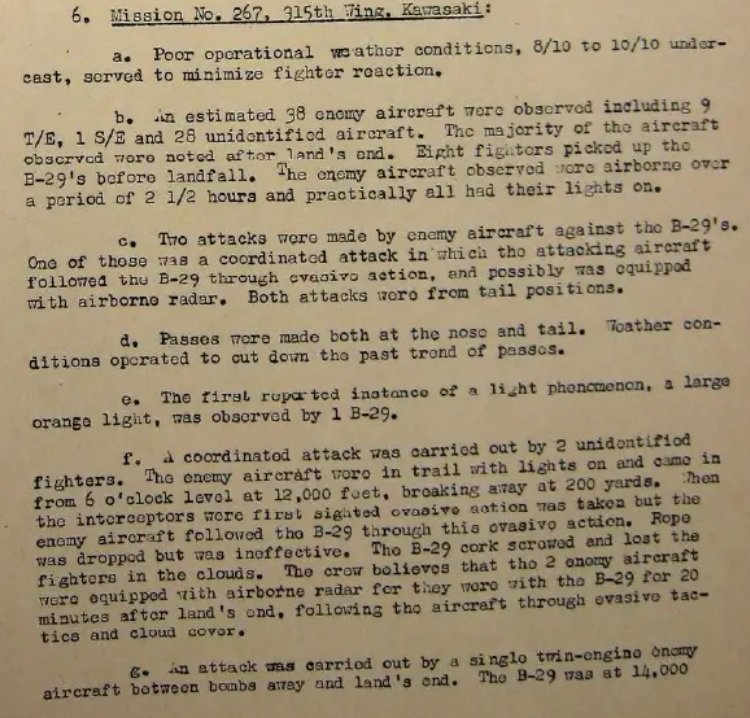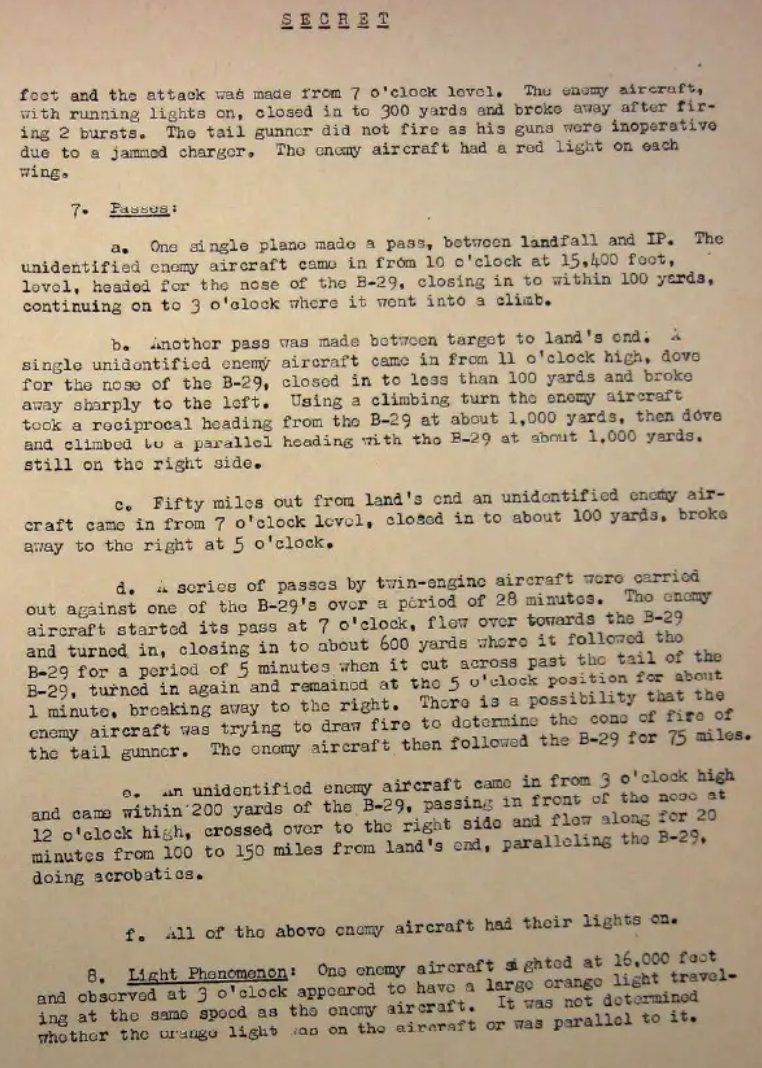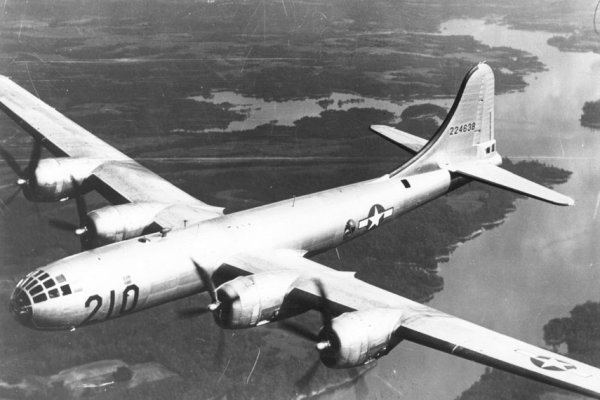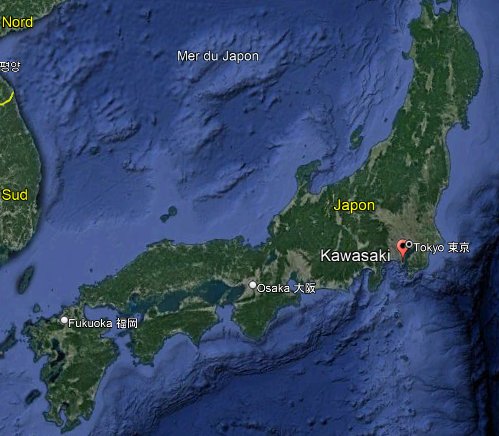ACUFO-1945-07-13-KAWASAKI-1
In a report from the XXIst Bomber Command of the United States Army Air Forces on their aerial attacks by their B-29s on 4 Japanese cities during the night of July 12-13, 1945, the “enemy opposition” section described, as it was always done, the enemy aircraft activities. For mission No. 267 carried out against Kawasaki, the different maneuvers of the Japanese planes are described, specifying that all these planes had their lights on.
There also appears, separately, a section entitled “luminous phenomenon”, that an enemy aircraft had been seen at 16,000 feet and observed at 3 p.m. from a B-29 “appeared to have a large orange light traveling at the same speed as the enemy aircraft.” the report specified that it “was not determined whether the orange light was on the aircraft or was parallel to it.” It was specified that ”it has not been determined whether the orange light was on the aircraft or whether it was parallel to it.”
This part of this report appeared in the 2000s in ufological sources.
| Date: | July 13, 1945 |
|---|---|
| Time: | Night. |
| Duration: | ? |
| First known report date: | July 13, 1945 |
| Reporting delay: | Hours. |
| Country: | Japan |
|---|---|
| State/Department: | Kanagawa |
| City or place: | Kawasaki |
| Number of alleged witnesses: | 1 or more. |
|---|---|
| Number of known witnesses: | ? |
| Number of named witnesses: | 0 |
| Reporting channel: | Military mission report. |
|---|---|
| Visibility conditions: | Night. |
| UFO observed: | Yes. |
| UFO arrival observed: | ? |
| UFO departure observed: | ? |
| UFO action: | Flew. |
| Witnesses action: | |
| Photographs: | No. |
| Sketch(s) by witness(es): | No. |
| Sketch(es) approved by witness(es): | No. |
| Witness(es) feelings: | ? |
| Witnesses interpretation: | Possible light on plane. |
| Sensors: |
[X] Visual: 1 or more.
[ ] Airborne radar: [ ] Directional ground radar: [ ] Height finder ground radar: [ ] Photo: [ ] Film/video: [ ] EM Effects: [ ] Failures: [ ] Damages: |
|---|---|
| Hynek: | NL |
| Armed / unarmed: | Armed, 12 Browning M2 12.7 mm machine guns. |
| Reliability 1-3: | 3 |
| Strangeness 1-3: | 1 |
| ACUFO: | Possible enemy plane with searchlight. |
[Ref. aaf1:] U.S. ARMY AIR FORCES:

|
The enemy opposition section of the missions report is, for Mission No. 267:
6. Mission No. 267, 315th Wing, Kawasaki:
a. Poor operational weather conditions, 8/10 to 10/10 undercast, served to minimized fighter reaction.
b. An estimated 38 enemy aircraft were observed including 9 T/E, 1 S/E and 25 unidentified aircraft. The majority of the aircraft observed were noted after land's end. Eight fighters picked up the B-29 before landfall. The enemy aircraft observed were airborne over a period of 2 1/2 hours and practically all had their lights on.
c. Two attacks were made by enemy aircraft against the B-29's. One of those was a coordinated attack in which the attacking aircraft followed the B-29 through evasive actions, and possibly was equipped with airborne radar. Both attacks were from tail positions.
d. Passes were made both at the nose and the tail. Weather conditions operated to cut down the pas trend of passes.
e. The first reported instance of a light phenomenon, a large orange light, was observed by 1 B-29.
f. A coordinated attack was carried out by 2 unidentified fighters. the enemy aircraft were in trail with lights on and came in from 6 o'clock level at 12,000 feet, breaking away at 200 yards. When the interceptor were first sighted evasive action was taken but the enemy aircraft followed the B-29 though this evasive action. Rope was dropped but was ineffective. The B-29 cork screwed and lost the fighters in the clouds. The crew believes that the 2 enemy aircraft were equipped with airborne radar for they were with the B-29 for 20 minutes after land's end, following the aircraft though evasive tactics and cloud cover.
g. An attack was carried out by a single twin engine enemy aircraft between bomb away and land's end. The B-29 was at 14,000

|
feet and the attack was made from 7 o'clock level. The enemy aircraft with running lights on, closed in to 300 yards and broke away after firing 2 burst. The tail gunner did not fire as his guns were inoperative due to a jammed charger. The enemy aircraft had a red light on each wing.
7. Passes:
a. One single plane made a pass, between landfall and IP [Initial Point]. The unidentified enemy aircraft came in from 10 o'clock at 15,400 foot, level, headed for the nose of the B-29, closing in to within 100 yards, continuing on to 3 o'clock where it went into a climb.
b. Another pass was made between target to land's end. A single unidentified enemy aircraft came in from 11 o'clock high, dove for the nose of the B-29, closed in to less than 100 yards and broke away sharply to the left. Using a climbing turn the enemy aircraft took a reciprocal heading from the B-29 at about 1,000 yards, then dove and climbed to a parallel heading with the B-29 at about 1,000 yards, still on the right side.
c. Fifty miles out from land's end an unidentified enemy aircraft came in from 7 o'clock level, closed in to about 100 yards, broke away to the right at 5 o'clock.
d. A series of passes by twin-engine aircraft were carried out against one of the B-29's over a period of 28 minutes. The enemy aircraft started its pass at 7 o'clock, flew over the B-29 and turned in, closing in to about 600 yards where it followed the B-29 for a period of 5 minutes when it cut across past the tail of the B-29, turned in again and remained at the 5 o'clock position for about 1 minute, breaking away to the right. There is a possibility that the enemy aircraft was trying to draw fire to determine the cone of fire of the tail gunner. The enemy aircraft then followed the B-29 for 75 miles.
e. An unidentified enemy aircraft came in from 3 o'clock high and came within 200 yards of the B-29, passing in front of the nose at 12 o'clock high, crossed over to the right side and flew along for 20 minutes from 100 to 150 miles from land's end, paralleling the B-29, doing acrobatics.
f. All of the above enemy aircraft had their lights on.
8. Light Phenomenon: one enemy aircraft sighted at 16,000 feet and observed at 3 o'clock appeared to have a large orange light traveling at the same speed as the enemy aircraft. It was not determined whether the orange light was on the aircraft or was parallel to it.
[Ref. prt4:] JAN ALDRICH - "PROJECT 1947":
N - 1945.07.12/13 - Night Japan.
B-29, Orange light paralleling the path of enemy aircraft. Unable to determine if it was part of aircraft. (Report on Attack of 4 Cities, 12/13 July 1945, HQ 21st Bomber Command)
[Ref. dwn2:] DOMINIQUE WEINSTEIN:
At night the pilot of a B-29 from the 315th Wing on mission #267 observed one large orange light phenomenon.
Sources: Project 1947, Jan Aldrich / Report on attack on 4 cities, 12-13 July 1945, HQ 21st Bomber Command.
(Ref. nip1:) "THE NICAP WEBSITE":
July 12, 1945; Honshu, Japan
Light phenomenon spotted enemy aircraft apparently trailed by large orange light traveling with it at same speed. (Page 186-187 Ref.1)
The reference 1 is described at the end of the document as “Strange Company (2007), Keith Chester”.
[Ref. tai1:] "THINK ABOUT IT" WEBSITE:
Date: July 12, 1945
Location: Honshu, Japan
Time:
Summary: Light phenomenon spotted enemy aircraft apparently trailed by large orange light traveling with it at same speed.
Source:
The Boeing B-29 “Superfortress” was the heaviest bomber of the U.S. Army Air Forces, used in operations from May 8, 1944 and on. Its maximum speed was 574 km/h.
Its defensive armament was 12 Browning M2 12.7 mm machine guns.

|

|
In this report like in some other reports, it is difficult to formally exclude the possibility that the light was a light on an enemy aircraft.
In this case specifically, it is even more difficult since the report clearly states that it “was not determined whether the orange light was on the aircraft or was parallel to it.”
In reports of similar missions from the XXIst Bomber Command, it is sometimes noted that enemy aircraft were equipped, in addition to their navigation lights and cockpit lights, with a powerful headlight or searchlight, certainly intended to illuminate the Americans aircraft to designate them either for the Japanese fighter planes or for the Japanese flak.
Possible enemy plane with searchlight.
* = Source is available to me.
? = Source I am told about but could not get so far. Help needed.
| Main author: | Patrick Gross |
|---|---|
| Contributors: | None |
| Reviewers: | None |
| Editor: | Patrick Gross |
| Version: | Create/changed by: | Date: | Description: |
|---|---|---|---|
| 0.1 | Patrick Gross | January 14, 2024 | Creation, [aaf1], [prt4], [dwn2], [nip1], [tai1]. |
| 1.0 | Patrick Gross | January 14, 2024 | First published. |